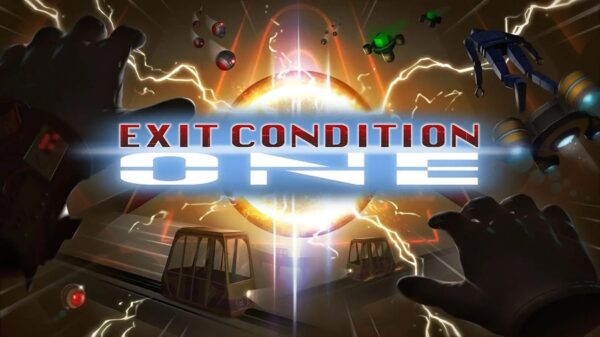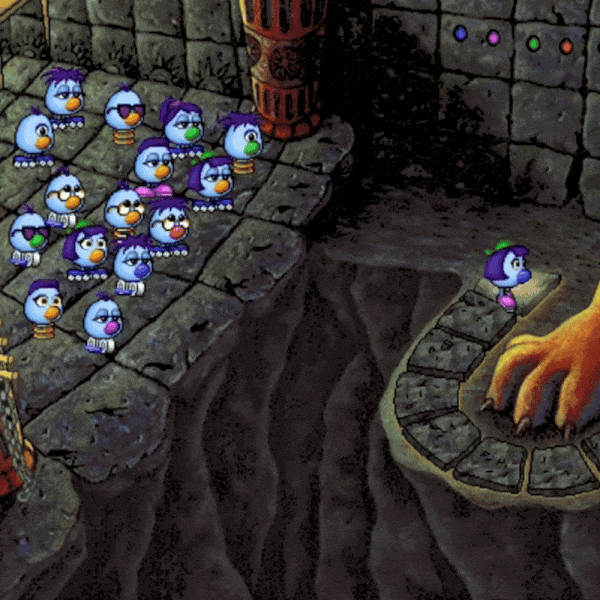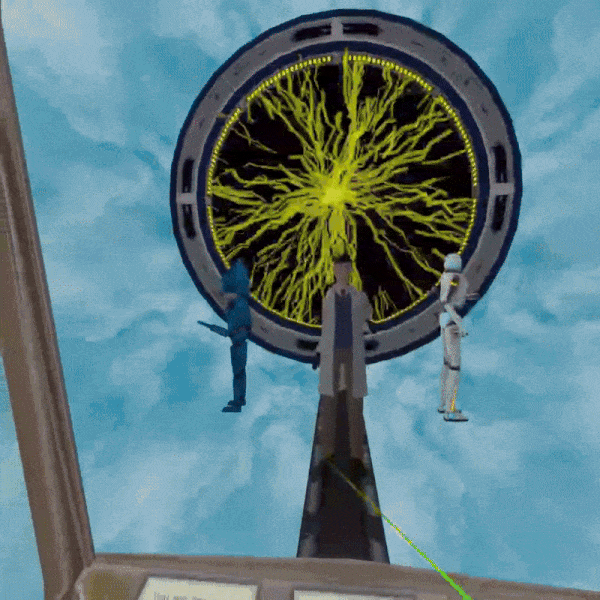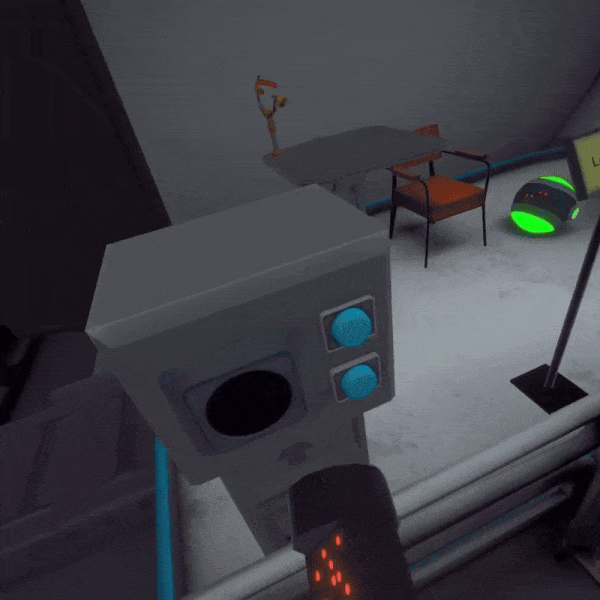
TL;DR for Exit Condition One
(played on a Meta Quest 3 128 GB model)
| Pros | Cons |
| + Unique, ambitious mechanics | – Buggy core controls |
| + Good value | – Repetitive sound design |
| – Middling graphics |
INTRODUCTION
Do you want to experience the claustrophobic thrill of an escape room without the hassle of pants?
Well then your potentially-nude dreams of immersive puzzlery are about to come true!
Whereas real-life escape rooms require both:
- friends, and
- the ability to endure the unblinking gaze of the world outside your apartment,
Exit Condition One—from developer Damon Poole—brings the chin-scratching stop-and-go “gameplay” of escape rooms directly to your VR headset!
And for a fraction of the price!
Packed with the content of two or three real-life escape rooms, Exit Condition One is a bargain at just 10 USD.
Now unlike most escape rooms, Exit Condition One is totally story-driven.
Actually—given the shift in medium and all of the trappings that come with it—I’m inclined to say that calling Exit Condition One an “escape room” experience is just a matter of framing.
Is Portal an escape room?
What about The Talos Principle?
Myst? King’s Quest?
ZOOMBINIS?

All of these games require that you solve some sort of puzzle before you can proceed to the next area, no?
So it seems to me that the thing that makes escape rooms special and distinct might be that you do them in-person.
But once you put a supposed “escape room” into a console, then it’s just a puzzle game, right?
I mean just because VR immerses our perspective more deeply into the game doesn’t make the videogame anything other than a videogame, does it?
Like if I play a platformer in VR does it become an “obstacle course simulator”?
Does a VR JRPG become a “sleepy and kind-hearted handsome boy with a big sword simulator”?
I hope not.
I hope not because that genre name is too long.
But also I just don’t think that’s how it goes.
I think there has to be a certain level of agreement with usual reality for a game to be defined thereby; the game has to actually try to feel like its real-life counterpart to claim to simulate it.

Why do I bring up this delineation?
Because how I categorically reckon with Exit Condition One determines how highly (or otherwise) I recommend it.
If I compare Exit Condition One to escape rooms then it stacks up pretty well!
It’s a fraction of the price. It’s much more convenient. And it’s more immersive (when it works).
If I compare Exit Condition One to puzzle games more broadly?
Well now things get a little dicey-
Let’s talk about it.
STORY
Exit Condition One’s weird and psychedelic intro really excited me!

I was absolutely wrapped as I cascaded through varying modes of gameplay in a liminal world of symbols, only to find out that that was just a dream sequence, transitioning into a much more standard conceit for a videogame story:
You wake up with amnesia, and an NPC helper is ready to help you as long as you’re ready to help them!
How?
By doin’ up some puzzles!
You exit cryosleep in a malfunctioning spaceship, where a robot (who I’m pretty sure is voiced by the developer) asks you to help him get things back to normal.
Throughout your puzzle-solving journey you’ll encounter a number of voice recordings—left behind by the ship’s lost inventor/proprietor—that illuminate the details of your mysterious surroundings.

Now I won’t say anything more here because I don’t want to spoil anything and also I couldn’t because I did not finish the game!
It isn’t very long, mind you.
But about three quarters of the way through the thing I rage-quit after having my progress bugged too many times on a level that already saw a lot of slow, clunky backtracking.
While it’s true that I suppressed the thought “if this happens one more time I’m quitting” maybe half a dozen times, it’s also true that journalistic integrity can only take you so far when the stakes are this low.
GAMEPLAY
If you haven’t read any of my other reviews, I’ll reiterate:
I always want the games I play to be good because I want to have fun!
I also just don’t like nit-picking other people’s art.
But, hey! That’s the gig, y’know?
So, Exit Condition One, prepare to have your nits frickin’ picked!
This game brims with cool, toy-like ideas, but their execution reveals the limits of a two-person development team.
Now some of these toys worked pretty well!
There was an in-game drone item that controlled nicely… and…
Actually now that I think about it, that may be the only interesting and ambitious mechanic that didn’t have some sort of technical caveat…
One example of many ambitious-yet-flawed in-game toys was an item-spawning gun.
I’d grab the front handle of this gun with what would otherwise be my off-hand, and by pressing that forward trigger I’d cycle through what item I wanted to spawn.
Then I’d pull the trigger on my main hand to spawn it.
Very cool idea for sure, but marred by the inconsistent placement of the off-hand.
That is to say that if you don’t grab exactly the right spot on the front of the gun with your off-hand, you’ll just do nothing and feel stupid when you press the trigger button.
You might be inclined to tell me that’s a skill issue, but I’ve played enough VR games with rifles in them to know that this isn’t a problem in any other game!
There’s just no good reason to let me grab another bit of the front of the gun that doesn’t do the thing that grabbing the front bit of the gun is supposed to do.
And that’s not a major issue at all!
But it’s a consistent one.
And that’s just it:
Exit Condition One has lots of small, consistent issues that add up to a gameplay experience which requires a lot of patience and charity on the part of the player.
Oh God.
Whenever I dig into an indie game like this I always think of the small teams who put their souls into their work and how they’ll probably read my review and I’ll break their precious hearts and I’m sorry, Damon Poole! I’m sorry and I love you!
If I had a robot friend in real life I’d wish his voice to be half as soothing as what I’m guessing is yours!
Still, you can’t just throw portals into your game willy-nilly without the physics engine to back that up!

But what about the puzzles?
Escape rooms are all about the puzzles, baby!
And on that front Exit Condition One does pretty good.
Only once did I consider the solution to a puzzle to be annoying or unfair.
Otherwise I found puzzles to be within a reasonable challenge window; pressing my problem-solving skills—forcing me to reassess—without ever totally beating me.
PRESENTATION
Not much redemption here, folks.
The visuals are never exceptional; mostly acceptable, and sometimes less than that.
A lot of animations are stiff, choppy, or just plain buggy. Some textures are muddy. And the few humanoid character models look truly amateur.

The sound design is tiresome.
The same few noises repeat again and again regardless of variance in speed, force, distance, or anything else in a way that feels just dated.
Let’s just swing the hammer already, shall we?
VERDICT
Is Exit Condition One a digital escape room or is it a videogame?
I think that needs to inform how we measure it and whether or not you should play it.
In short:
If you’re looking for an escape room experience and don’t mind doing it solo, Exit Condition One is an immersive offer at a good value; all baked up with novel sci-fi tech that real life just can’t replicate.
But – if it looks like a videogame and quacks like a videogame then it’s probably a videogame.
And while, from that angle, there are some positives I’ve yet to note—like its replayability-boosting easter egg hunt or its consistent and smooth frame-rates—overall, Exit Condition One is too bogged down by the mire of its flaws for its bevy of toys to shine through.
Out-of-the-box thinking here is crippled by a sheer lack of resources to have those big interesting gameplay ideas realized.
So for all its ambition, it gets a kudos.
But for its execution, Exit Condition One gets a 4/10.
Hyper-Objective Omniscient Evaluation Yardstick
Scores are out of 10, where 10 is a masterpiece, 1 is unplayable, and 5 is just average.
Gameplay has a heavier weighting toward the overall score.
Gameplay – 4
Immersion – 5
Visuals – 3
Sound – 3
Performance – 6
Replayability – 3
Image / video credit: Auganix / Exit Condition One
About the author
Kierkegaard once said that the artist is like one stuck inside Phalaris' brass bull, which burned up its victims and—due to the formation of its apertures—made beautiful music from their anguish.
The critic, he said, is just like the artist except he doesn't have the anguish in his heart nor the music on his lips.
A lifelong gamer based out of Vancouver, Pelé disagrees with Kierkegaard.
